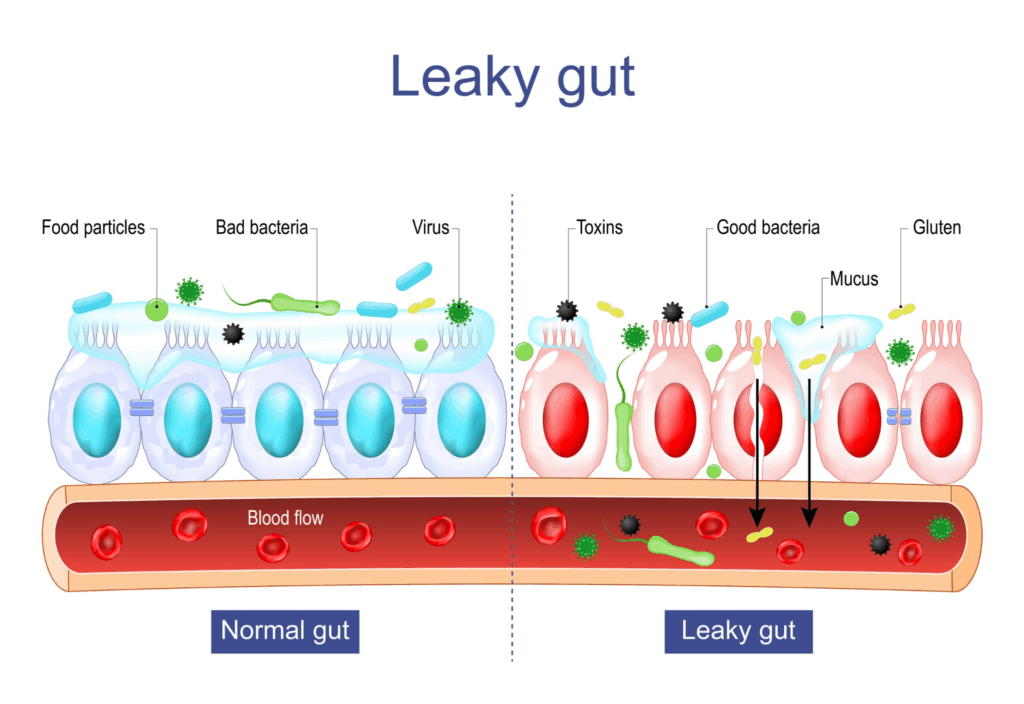
What is BPC-157?
BPC-157 (Body Protection Compound-157) is a short chain of amino acids (a peptide) that was first found in stomach acid. What makes it special is that it seems to survive the harsh environment of the gut and help the body protect and repair tissues, especially in the digestive tract.
While it’s not an approved treatment, researchers have been studying it for over 30 years for its potential in healing stomach ulcers, reducing gut inflammation, and strengthening the gut lining.
How It Supports Gut Health
Think of your gut lining as a protective wall. If that wall is damaged, food particles, toxins, or bacteria can slip through, leading to irritation, inflammation, and sometimes conditions like “leaky gut.” BPC-157 appears to help rebuild and protect that wall in a few important ways:
- Better blood flow for healing: It encourages tiny new blood vessels to form and improves circulation, which brings nutrients and oxygen to damaged tissue.
- Protecting the lining: It helps maintain the “tight seal” between gut cells, which can reduce leaks and irritation.
- Calming inflammation: Studies suggest it reduces swelling and tissue damage after injury or stress.
In plain language: BPC-157 helps the gut lining heal faster, seal tighter, and stay calmer under stress.
Layperson Analogies: How BPC-157 Works
Sometimes the science is easier to picture with a metaphor. Here are three ways to imagine BPC-157’s role in the gut:
- 🛠 The Repair Crew: Imagine your gut lining as a brick wall. Over time, bricks can crack and mortar can crumble. BPC-157 acts like a specialized repair crew, patching up cracks, restoring missing mortar, and keeping the wall strong.
- 🚰 The Plumbing Fix: The gut lining is like a water system that must not leak. When “pipes” get weak, BPC-157 steps in like a plumber, tightening the joints and stopping drips before they flood the basement (your bloodstream).
- 🌱 The Gardener: Healing tissue is like a garden that needs water and nutrients. BPC-157 encourages new “irrigation lines” (blood vessels) to sprout, so the garden of your gut lining gets fed and recovers more quickly.
Conditions Where It May Help
- Leaky gut: Though not an official diagnosis, many people experience increased intestinal permeability. Animal studies show BPC-157 helps restore barrier function.
- Inflammatory bowel disease (Crohn’s, ulcerative colitis): In rodent studies, it reduced inflammation and sped up tissue repair. Early human studies in ulcerative colitis patients showed it was well-tolerated and potentially helpful, but more research is needed.
- Irritable bowel syndrome (IBS): No direct studies exist, but by calming the gut lining and nerves, some speculate it may ease symptoms indirectly.
- General gut resilience: Because it supports healing, some view it as protective against everyday irritants like NSAIDs (painkillers), alcohol, or stress.

What the Science Says (in Numbers)
- In rat ulcer models, BPC-157 sped up healing of intestinal ulcers in as little as 3–7 days. By contrast, untreated control animals usually required about 14 days—and in some cases up to 25 days—to reach similar closure. In other words, BPC-157 cut healing time in half or better compared to controls.
- In inflammatory bowel disease models, treated groups had lower inflammation scores and less colon damage.
- Early human ulcerative colitis studies reported good safety and signs of symptom improvement, though they were small and outdated.
Commonly Reported Protocols
Note: These are research-use only, not medical advice.
- Oral capsules: 250–500 mcg per day, often split morning and evening.
- Subcutaneous injection: 250–500 mcg once or twice daily.
- Typical duration: 2–4 weeks, sometimes extended to 6–8 weeks for chronic conditions.
Because it appears stable in stomach acid, many prefer oral use for gut-specific issues.
Other Peptides to Know
While this article focuses on BPC-157, one other peptide worth mentioning is GHK-Cu (a copper-binding peptide). GHK-Cu is best known for skin and tissue repair, but in recent studies it also improved gut lining strength and reduced inflammation in colitis models. Some researchers think combining it with BPC-157 may support both healing and inflammation control in the gut.
Safety
So far, BPC-157 has shown a good safety profile in animals and early human studies, with no lethal dose identified. But long-term effects are unknown, and it hasn’t gone through modern FDA trials. Always use caution with experimental compounds.
Takeaway
- BPC-157 is a naturally derived peptide that may help repair and protect the gut lining.
- Evidence is strongest in animal models; human trials are limited but encouraging.
- People exploring gut healing often see it as part of a broader plan that includes diet, stress reduction, and sleep.
- More research is needed before it can be considered a standard therapy.
References
- Seiwerth S, et al. Stable Gastric Pentadecapeptide BPC-157 and Wound Healing. Front Pharmacol. 2021;12:627533.
- Hsieh M-J, et al. Therapeutic potential of pro-angiogenic BPC-157 via VEGFR2 activation. J Mol Med (Berl). 2017;95(4): 1–14.
- Sikiric P, et al. BPC-157–NO system relation. Curr Pharm Des. 2014;20(7):1126–1135.
- Duzel A, et al. BPC-157 in colitis and ischemia-reperfusion models. World J Gastroenterol. 2017;23(28):5159–5177.
- Mao S, et al. GHK-Cu alleviates DSS-induced colitis by enhancing tight junctions. Front Pharmacol. 2025;10:1551843.
- Sikiric P, et al. The influence of BPC-157 on rat acetic-acid gastric ulcers: faster healing vs prolonged control recovery. Acta Pharmacol Sin. 1999.
- Sikiric P, et al. BPC-157 and peptic ulcer healing in rats. J Physiol Paris. 1997.